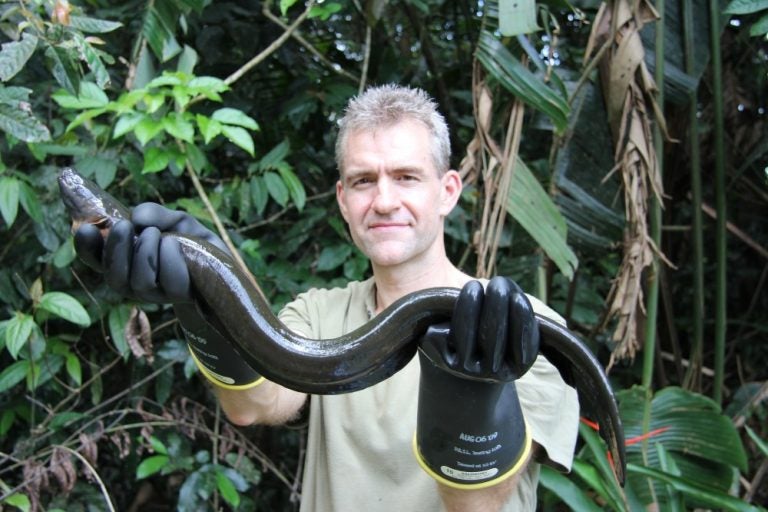University of Central Florida biologist William Crampton will take television viewers on a journey to capture an electric eel and measure its voltage in an episode of the new National Geographic TV series, Animal Superpowers.
The episode makes its United States premiere at 8 p.m. Sunday, June 3, on the Nat Geo WILD channel. Actor Patrick Stewart, known for his roles on Star Trek and the X-Men movies, narrates the series.
The episode that features Crampton’s trek to South America to capture the eel also includes a visit to Hawaii where the octopus’ remarkable ability to change color and skin texture for camouflage is showcased. A salamander from California that has the ability to regenerate its body parts is also featured.
In the episode, Crampton does for the viewing audience what hasn’t been done in more than 70 years – he measures the voltage of an electric eel in its natural habitat.
“Evolution has resulted in some remarkable adaptations in living organisms, and this series highlights some of the most unusual adaptations in the animal kingdom,” Crampton said. “To see these animal superpowers is not only fascinating and entertaining, but also reminds us of the incredible beauty of the natural world. Sadly many of the creatures that are featured in this film live in habitats that are threatened by human activity.”
For example, the electric eel lives in fragile rainforest ecosystems threatened by deforestation, mining, and hydroelectric dams.
“I have traveled to the Amazon every year now since 1993 for research and every time I see more and more destruction,” Crampton said.
Crampton traveled from Orlando to Suriname in July 2011, where he met the film crew. The three-person team spent a week looking for eels and captured one eel only two days before the trip would conclude.
“I don’t routinely examine the voltage of these animals, so I was keen to take up the challenge,” Crampton said about one of the reasons he agreed to travel deep into the jungle for television.
The assistant professor’s team at his UCF lab helped devise the special equipment he used to capture the eel and measure its voltage, which was near 500 volts.
Electric eels increase in voltage at a rate of around 100 volts for every 10 centimeters of body length until they reach around ½ meter long. Thereafter they don’t increase further in voltage – no matter how big they get. The largest specimens reach about 2 meters long.
After catching an electric eel, and getting a minor shock in the process, Crampton smiled as his gloved hands held the creature.
“I suppose some people might think these are rather ugly, slimy creatures, but for me they are absolutely beautiful – really magnificent animals,” Crampton said.
Crampton, an expert in electric fish, including electric eels, has served as a consultant for many wildlife films – including productions by the BBC, Discovery Channel, and National Geographic TV.
“I think there is a strong conservation message that comes from natural history films, which resonates among many people,” Crampton said. “ And that is, we really do stand to lose some of the treasures of the natural world if we’re not careful to conserve them.”
Crampton’s lab investigates the ecological, behavioral, and evolutionary mechanisms that generate and regulate aquatic species diversity in the tropics. The team is interested in how biodiversity is generated and maintained, how resilient it is to human pressure, and how it can be protected.
Crampton has a Ph.D. in ecology and evolutionary biology from the University of Oxford. Before coming to UCF, he was a senior researcher at the Mamirauá Institute Amazonas in Brazil, an assistant scientist at the Florida Museum of Natural History at the University of Florida, and a visiting research fellow at the University of Toronto. He has been an assistant professor at UCF since 2006, and the National Science Foundation funds much of his research.
For a short sneak peak of Crampton’s episode, click here .
